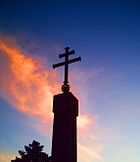Austin Dowling
| Austin Dowling | |
|---|---|
| Archbishop of St. Paul | |
 | |
| Diocese | Saint Paul, Minnesota |
| Installed | 1919 |
| Term ended | 1930 |
| Predecessor | John Ireland |
| Successor | John Murray |
| Orders | |
| Ordination | June 24, 1891 |
| Consecration | April 25, 1912 |
| Personal details | |
| Birth name | Daniel Austin Dowling |
| Born |
April 6, 1868 New York City, New York |
| Died |
November 29, 1930 Saint Paul, Minnesota |
| Denomination | Roman Catholic Church |
Austin Dowling (April 6, 1868 – November 29, 1930) was an American prelate of the Roman Catholic Church who served as the first bishop of the Diocese of Des Moines and the second Archbishop of the Roman Catholic Archdiocese of Saint Paul and Minneapolis.
Biography
Early life and education
Dowling was born in New York City on April 6, 1868, to Daniel and Mary Teresa Santry Dowling. On April 19 was baptized, and given his Christian name Daniel Austin. Not long after, his family moved to Newport, Rhode Island. At Newport, he was a student at the Academy of the Sisters of Mercy. Dowling attended Manhattan College in New York City, and graduated with his A.B. degree with high honors in 1887.[1]
Dowling made his theological studies at St. John's Seminary in Brighton, Massachusetts, and at the Catholic University.
Ordination and ministry
Dowling was ordained to the Roman Catholic priesthood on June 24, 1891 for the Diocese of Providence.[2] Afterwards, he worked on his graduate studies in theology and church history at the Catholic University.
After serving as a pastor in Warren, Rhode Island for a year, Dowling went to the Brighton Seminary where, for two and a half years he taught Church History. History was always a passion of Dowling. Marvin O'Connell stated that he was "a man who was by taste, habit and profession an historian; he could not set about finding solutions to problems facing him until he examined those problems in the light of the past."[3] Even his sermons as Bishop of Des Moines and as Archbishop of St. Paul were mainly of an historical character.[4] He was one of the first to welcome the creation of the Catholic Historical Review, and one of the first life members of the American Catholic Historical Association.[4]
Later, in 1896, Dowling spent two years as editor of the Providence Visitor, and became one of the better known Catholic editors in the United States. Afterwards, he was assistant at St. Joseph's, Providence, then pastor of St. Mary's, Warren and then rector of the Providence Cathedral.[5]
Bishop of Des Moines, Iowa
In 1912, the Holy See appointed Dowling as the bishop of the Diocese of Des Moines, Iowa. His peers saw the action as recognition of his talents,[5] while Dowling felt as if he were being sent into "exile" in the West.[1]
Dowling had a fine intellect and excellent organizational skills. As Bishop of Des Moines, Dowling was appreciated for his courage, simplicity, kindness, and especially his commitment to education. He founded a Catholic college in Des Moines.[1]
Archbishop of Saint Paul
On January 31, 1919, Dowling was appointed to be Archbishop of Saint Paul, Minnesota. In his address at his installation on March 25, 1919, Dowling described himself as "the unknown, the unexpected, [and] the undistinguished successor of the great Archbishop Ireland."[6]
In the decade that followed, Dowling had many accomplishments, including: The establishment of the Archbishop Ireland's Education Fund; the improvement of St. Paul Seminary; and being on the board of Education of the Catholic National Welfare Conference (now known as the United States Conference of Catholic Bishops or USCCB). He was known for his contributions to education and love of Church history.
Later years
During the last years of his life Archbishop Dowling's health was seriously impaired because his heart was not functioning normally, and the resultant circulatory disorders gave rise to complications that were life-threatening on several occasions.[6] During the summer of 1929 he collapsed while on a confirmation tour and a critical illness resulted. For a time he recovered to the point that he was able to walk on his own, but pneumonia developed. Dowling lapsed into unconsciousness four hours before his peaceful death in the late morning of Saturday, November 29, 1930, at his residence on Summit Avenue, directly across from the St. Paul Cathedral.[6]
Influence
The Church in America
In the first decade of the 20th century, immigration jumped from a low of 3.5 million in that decade to a high of 9 million due to the depression of the 1890s. "After 1914, immigration dropped off because of the war, and later because of immigration restrictions imposed in the 1920s."[7] Lack of immigration cause certain difficulties in the Catholic Church in America, who relied heavily on its head in Europe. Dowling described the challenge for Catholics in the post-World War I era as follows:
The old order passeth, giving place to the new. Immigration has all but ceased, and when revived—if it is ever permitted to revive—it is not likely to attain the proportions of the former days. …Language, customs, memories, pass with a generation. So far, the Church in this country has been singularly sustained by the momentum of spiritual agencies that were derived from other lands and other times. In the new day there will be no such powerful auxiliary to supplement our own normal activity. It will be the American Catholic Church or it will be nothing.
The challenge for American Catholics during the 1920s was that immigrants came to America poor and disadvantaged and they associated the catholic religion with their old countries. As immigrants improved their quality of life and became more "American," culture and religion was lost and forgotten. Dowling summarized it best saying, "as they progress in wealth and station they frequently strive to hide their origins, to change their names and affect manners that do not belong to them. Even when they keep up the practice of their religion, they are frequently ashamed of it.[9]"
Dowling argued that the solution would be to convince people that "foreignism" and Catholicism were not intimately linked.[1] World War I provided opportunity for Catholics to prove their patriotism. The National Catholic War Council was established to coordinate programs for Chaplains and refugees, and develop ecumenical and interfaith relations.[1]
The Council also fostered Catholic unity across the United States, leading to the postwar organization of the National Catholic Welfare Conference in 1919. Five departments were organized: Education, Social Work, Press and Literature, Lay Societies, and Home and Foreign Missions. Dowling was named treasurer and chairman of the Department of Education.[1] He served in those positions for a decade until his condition of health required that he give up the duties. Presently, the Church operates the world's largest non-governmental school system.[10]
Archbishop Ireland Educational Fund
.jpg)
At the first anniversary requiem for his predecessor, Dowling commemorated Archbishop John Ireland's contributions to education and mandated the establishment the Archbishop Ireland Educational Fund.[6] He said that the present needs for education were "to develop, coordinate and consolidate the education system to provide for greater efficiency."[6] To accomplish this he announced a campaign to raise $5,000,000.[1]
After 5 years, in September 1925, 45,551 people had pledged a total of $4,392,872.50, but 21,898 had made no payments. Unpaid pledges amounted to $1700,000.[6] Efforts were made to collect delinquent pledges, and before the end of the year the number was reduced, leaving 5,375 delinquent pledges in St. Paul; 6,303 in Minneapolis; and 9,042 in the country. The average individual pledge was around $100.[6]
The largest allocation of the fund was $1,280,000 for the "construction and partial endowment of the preparatory seminary known as Nazareth Hall." Other major allocations include: $200,000 to the endowment fund of the College of St. Catherine. $150,000 to St. Thomas College.[6]
The preparatory seminary was built on property on the shore of Lake Johanna, outside the corporate limits of the Twin Cities.[6] Rearden describes Dowling's relationship with the school:
Nazareth Hall was the apple of his eye and woe betide the priest or layman who dared to utter an uncomplimentary syllable about the institution, its architecture, location, purpose, faculty, or product. Every other institution in the diocese was a step-child, seldom visited except officially. At Nazareth Hall a suite of well-furnished rooms was set apart for him to which he retired from time to time to rest and recuperate and breathe the invigorating suburban air.[6]
St. Paul Seminary

The establishment of Nazareth Hall had a large impact on the St. Paul Seminary. Thereafter, the majority of the students would be prepared in a cloistered environment, which Dowling believed was more appropriate than a college campus.[1] Dowling believed that the priest of the future "should be armed before to overcome the temptations of the times,"[1] and that the best was to do that was to ground them on the firm foundation of interior life and school them in the practice of priestly virtues.
Dowling also believed in the rigors of academic challenge, from his years at the Brighton college.[1] To create the strong theological factory he desired, Dowling appointed Humphrey Moynihan as rector of the Saint Paul Seminary.[1] Moynihan emphasized culture and refinement in his teaching.
Dowling had a personal interest in the seminarians attending the school. It was said that the Archbishop had "a keen eye for every candidate for the priesthood."[11] In fact, he knew many of the boys at Nazareth Hall as well as their teachers knew them.[11] Many felt that his influence on their lives continued on after their leaving Saint Paul Seminary, to ordination and beyond.[11]
Nazareth Hall closed in 1970. The former Nazareth Hall building is now part of the Protestant evangelical University of Northwestern – St. Paul campus and is one of the university's two main administrative buildings. The building retains the name "Nazareth Hall." Much of its original Catholic architecture remains intact, including the main chapel and the Stations of the Cross. Though Northwestern espouses Protestant theology and the student body is overwhelmingly Protestant, the school accepts Catholic student applications, and there is a very small minority of Catholic students on campus.
See also
References
- ↑ 1.0 1.1 1.2 1.3 1.4 1.5 1.6 1.7 1.8 1.9 1.10 Athans, Mary Christine. "To Work For The Whole People"; John Ireland's seminary in St. Paul. Mahwah, NJ: Paulist Press, 2002. p 135-167 ISBN 0-8091-0545-4
- ↑ "Archbishop Austin Dowling." Catholic-Hierarchy. Retrieved on 12/09/2008.
- ↑ As quoted by Athans: O'Connell, Marvin. The Dowling Decade in Saint Paul. Unpublished M.A. dissertatoin, the Saint Paul Seminary, 1955, p.53
- ↑ 4.0 4.1 "Archbishop Austin Dowling" Catholic Historical Review 16(1930/31): 477.
- ↑ 5.0 5.1 "RIGHT REVEREND AUSTIN DOWLING." Catholic University Bulletin 18 (1912): 281.
- ↑ 6.0 6.1 6.2 6.3 6.4 6.5 6.6 6.7 6.8 6.9 Reardon, James(1952) The Catholic Church in the Diocese of St. Paul. p. 435-505 St. Paul, MN: North Central Publishing Company
- ↑ Immigration in the early 1900s, EyeWitness to History,(2000). Retrieved on 12/10/08
- ↑ Dowling, Austin. "Dedication of Suplician Seminary, Washington, D.C.," sermon preached September 23, 1919, Sermons, p. 12 Emphasis Added
- ↑ As quoted by Athans:Ad Limina Report (Draft 1923), Austin Dowling Papers (DP), AASPM
- ↑ Gardner, Roy; Denis Lawton; Jo Cairns (2005). Faith Schools. Routledge. p. 148. ISBN 978-0-415-33526-3.
- ↑ 11.0 11.1 11.2 As quoted by Athans: Humphrey, Moynihan to Mrs. E. E. [Clara Hill] Lindley, St. Paul, December 18, 1927.
External links
Episcopal succession
| Catholic Church titles | ||
|---|---|---|
| Preceded by John Ireland |
Archbishop of Saint Paul and Minneapolis 1919–1930 |
Succeeded by John Gregory Murray |
| Preceded by None |
Bishop of Des Moines 1911–1919 |
Succeeded by Thomas William Drumm |
| |||||||||||||||||||||||||
| |||||||||||||||||||||||||||||


